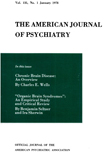Psychoanalytic Thought on Phobia: Its Evolution and Its Relevance for Therapy
Abstract
The development of psychoanalytic thought on phobia is traced from Freud's demonstration of the unconscious pathways that select the phobic topos, through the distinctions of the various phase-conditioned sources of anxiety, to the present conception of a structural intraphychic disequilibrium which the phobic symptom seeks to balance. Analytic treatment uncovers the genetic sources of the imbalance and, by fostering a new equilibrium, increases the ego's capacity to cope with conflict.
Access content
To read the fulltext, please use one of the options below to sign in or purchase access.- Personal login
- Institutional Login
- Sign in via OpenAthens
- Register for access
-
Please login/register if you wish to pair your device and check access availability.
Not a subscriber?
PsychiatryOnline subscription options offer access to the DSM-5 library, books, journals, CME, and patient resources. This all-in-one virtual library provides psychiatrists and mental health professionals with key resources for diagnosis, treatment, research, and professional development.
Need more help? PsychiatryOnline Customer Service may be reached by emailing [email protected] or by calling 800-368-5777 (in the U.S.) or 703-907-7322 (outside the U.S.).



